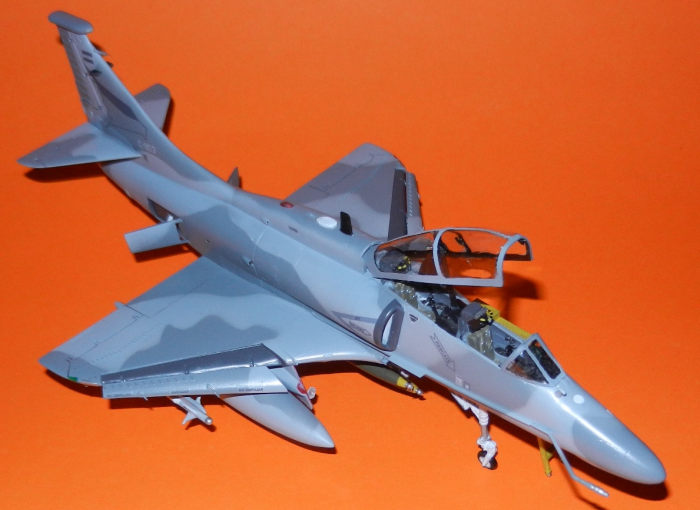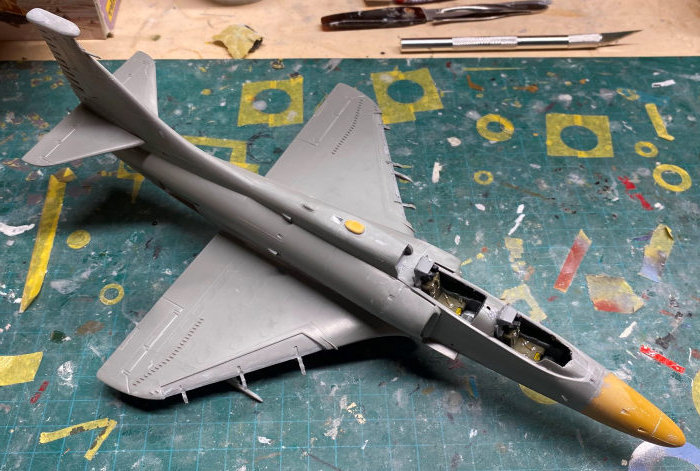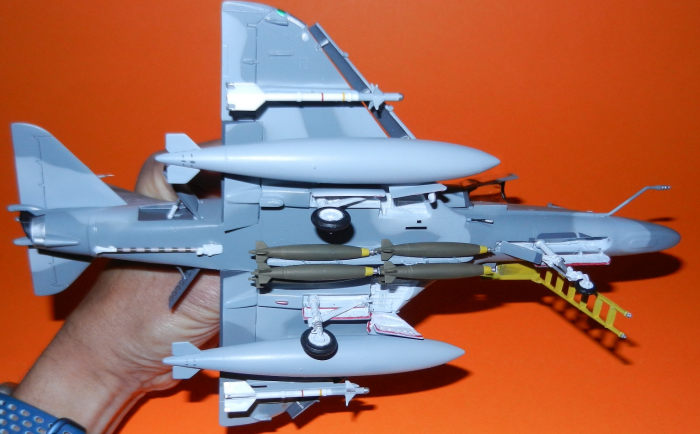
| KIT #: | 5436 |
| PRICE: | CAD$20.00 'used' |
| DECALS: | One option |
| REVIEWER: | Pablo Calcaterra |
| NOTES: | Condor decals, nose and antennas |

| HISTORY |
The Argentine Air Force had successfully used the 75 Skyhawks it had been incorporating since the late 60s till the mid-70s (50 x P and 25 x C).
These squadron inflicted most of the losses to the British Task Force in 1982 (HMS Glasgow and HMS Argonaut out of combat, HMS Antelope, HMS Coventry, landing craft Foxtrot 4 sunk, RFA Sir Galahad and RFA Sir Tristam badly damaged (one was eventually scuttled) and damages to many other warships. The only ships not sunk by the Skyhawks were HMS Ardent (though Capitan Caballo attacked her singlehanded first) and the two ships sunk by the Exocets (HMS Sheffield and LCT Atlantic Conveyor). The cost for the Squadrons was high in material (10 x P and 9 x C) and pilots (only two survived their ejections).
 Therefore after the war
the number of planes had dropped dramatically taking into account the accidents
that had happened during their previous years of service.
Therefore after the war
the number of planes had dropped dramatically taking into account the accidents
that had happened during their previous years of service.
Due to the boycott of the British that still continues to take place the Argentine Air Force was unable to secure replacements for the planes lost in the war, including the Daggers and MIII (that’s another article).
During the late 80s and early 90s Argentina was developing a very successful launching platform called Condor II. Fear that the technology would risk the Islands and a argued contact with the Iraqis (Saddam Hussein) led to a massive amount of diplomatic pressure to kill the project. It is said that one of the tokens exchanged to kill Condor II was the supply of 36 A-4M fully refurbrished and totally customized to the Argentine’s will. These were called A-4AR.
In 1992 the US released some Skyhawks that were in storage. Originally it was 54 planes but they were “as is”. The Chief of Staff of the Air Force argued against this with the Defense Minister and he retired. In 1993 a contract to buy 36 to be modernized planes was signed and Smith Industries, who had done the same for the Kiwi Air Force was chosen to do the work. The following year Lockheed took over the Fabrica Militar de Aviones in Cordoba and after some negotiations it was decided that 18 of the planes were going to be modernized in Argentina. Breaking the contract with Smith meant that the Argentine Government was sued…
The project was called “Fightinghawk” and was led by Commodore Mir Gonzalez, who had flown Daggers in 1982. The planes were stored in AMARC (California) and were hand picked by the Argentines. They had to have more than 60% remaining flying hours.
 Ground crew and pilots
started their training on the new technology in the US. ON August 1st 1995 C-906
flew for the first time from Davis Monthan AFB. It was nicknamed Gaucho 01. This
was the first prototype but had to be replaced because it had structural
problems. Due to delays and budget cuts the delivery was delayed from 1995 to
1999.
Ground crew and pilots
started their training on the new technology in the US. ON August 1st 1995 C-906
flew for the first time from Davis Monthan AFB. It was nicknamed Gaucho 01. This
was the first prototype but had to be replaced because it had structural
problems. Due to delays and budget cuts the delivery was delayed from 1995 to
1999.
The first planes flew to Argentina in what was called “Ferry 1” along with a aKC-130 and a F-28. They were OA-4AR C-903 and A-4AR C-906, C-908, C-917 and C-918. They departed on December 13 and arrived in Argentina 5 days later. Mir Gonzalez became the leader of the famous V Brigada Aerea in San Luis and Commodore Jorge Senn (another 1982 Dagger pilot) replaced him as leader of the program.
Deliveries of the US and Lockheed Argentina planes happened during 1999 with the last planes (upgraded in Cordoba) joining the Air Force early 2000.
The A-4ARs have a radar altimeter AN/APN-141 (that had to be relocated as it interfered with some electronics), VHF, UHF, ECM AM/ALQ-126, RWR, VOR, IFF AN/APX-72, radar is Westinghouse ARG-1 (a version of the APG-66 present in the F-16C Block 30), SHUD, 2 x MFD, HOTAS, Ground Mission Planning System. These planes are clearly a jump forward in terms of technology for the Argentine Air Force. They are the primary ground attack planes in the FAA Though the trick is that the planes were not received with modern armament…not even Sidewinders for self defense…and have resorted to use the old iron bombs from 1982. Lately more modern armament (LGBs for instance) have been implemented and a few Sidewinders L/M as well.
.After 25 years of service 4 planes have been lost in accidents. Limitations on budgets mean that the out of the 36 planes there might be enough in flying condition to count them with the fingers of one hand. The rest are in storage. A sad state of affairs.
| THE KIT |
You can refer to Scott’s preview for kit details. Decals I got from Fabian Vera at Condor Decals used to have a set of resin parts of great quality (all the antennas, a new nose, instrument panel) suitable for the AR. Sadly all his efforts were wasted when another company cloned his resin set and started to sell it. Thus Fabian has decided to discontinue his.
| CONSTRUCTION |
 I had to chop the nose to later on add the resin one.
The plane falls in place quite easily. There some
putty required along the fuselage and the electronics on top of the tail but
otherwise it is a very simple kit. I had to play a bit with putty and sandpaper to ensure
a smooth surface between the resin nose and the fuselage. There were some air
bubbles that were not too hard to eliminate.
I had to chop the nose to later on add the resin one.
The plane falls in place quite easily. There some
putty required along the fuselage and the electronics on top of the tail but
otherwise it is a very simple kit. I had to play a bit with putty and sandpaper to ensure
a smooth surface between the resin nose and the fuselage. There were some air
bubbles that were not too hard to eliminate.
The kit is missing the vent on the electronics hump. I scratchbuilt it with Evergreen and I opened a hole large enough to accept it. I am very proud of this representation…though later on working on another project I found several of these in my spares that came from the Hobbycraft A-4s (rolling eyes)
All the tiny antennas were attached with cyano (gel) and a bit of Mr Surfacer was used to blend them in position. Same happened with the very thin and delicate cone for the drag parachute. The only area where I struggled was opening the front cockpit to make it accept the beautiful resin instrument panel. Added the landing gear minus the wheels.
| COLORS & MARKINGS |
Air intakes, landing gear and wheel bays were painted white. These planes are painted with FS36375 and FS36270 which came from the ModelMaster Acrylic range.
Sidewinders (from spares) were painted as needed. Same applies to the antennas (some white, some black, some cammo). The forward IFF (top of nose, white circle) was carefully painted with a brush. The windshield and canopy were primed in black after they had been masked.
 It was a fairly easy affair except for some masking
(airbrakes, slats, cammo). Several light coats of Future prepared the kit for the
decals.
It was a fairly easy affair except for some masking
(airbrakes, slats, cammo). Several light coats of Future prepared the kit for the
decals.
Condor Decals. Perfect register, several options. Very good ones. Those for the Sidewinders M were made printing in clear film the stripes in the correct colours.
Added landing gear doors, drop tanks and missiles in that order (working from the center line to the wing tips). Added 6 x 250 lb bombs from Hobbycraft and the access ladder from the kit.
The exhaust was glued having been previously been painted in a mix of black and aluminum. Some delicate antennas and the refuelling probe were added. Finally the windshield, and the canopy with some photoetched rear mirrors were glued in place and the project was completed.
| CONCLUSIONS |
And easy build that completes my Argentine Skyhawk timeline. There was yet another P (or B whichever way you want to call them) that was put together and became my last (no more!) Skyhawk. But that could be another write up.
| REFERENCES |
La Gaceta Aeronautica (website)
15 June 2023 Copyright ModelingMadness.com. All rights reserved. No
reproduction in part or in whole without express permission. If you would like your product reviewed fairly and fairly quickly, please
contact
the editor or see other details in the
Note to
Contributors.